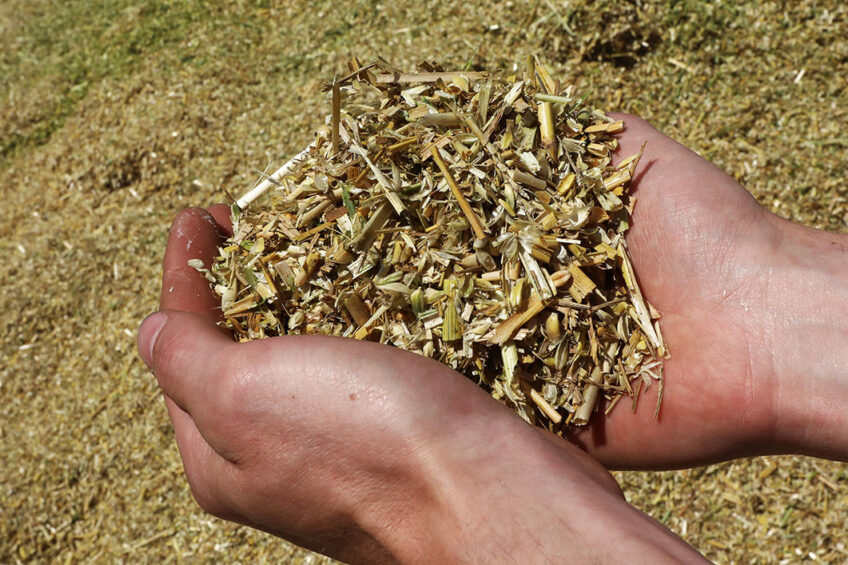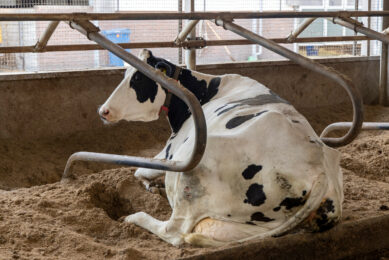Fighting mastitis with feed strategies

Mastitis continues to be a problem for dairy producers, afflicting 15–20% of cows worldwide. We look at controlling mastitis through feed strategies.
Mastitis causes economic loss due to treatment costs, lost quarters, potential animal deaths, and, most importantly, discarded milk. Management strategies can have a large impact on the prevention of mastitis. However, there is growing evidence that nutrition can have significant effects on the immune system, thereby affecting infection rate and severity of mastitis. The following is a review of the nutritional factors to be considered for the control of mastitis.

Feeding of silage and hay
Poor quality silage negatively affects the immune system of the animal. The overheated proteins and sugars may kill the white blood cells protecting the udder. Cows that are fed on hay and grain have greater resistance to several pathogens than cows fed on poorly fermented silage. Pseudomonas and Proteus can survive even the high temperatures produced in silage. Silage contaminated with these microbes may then be a source of mastitis. Even mouldy hay and mycotoxins may destroy white blood cells and therefore weaken the immune system.

Alfalfa and other legumes
Legumes, particularly alfalfa, are high in oestrogenic substances whose concentration varies depending on plant maturity. Turning these legumes into silage does not reduce the oestrogenic properties that are responsible for fostering mastitis. Intake of a large quantity of oestrogenic legume encourages premature development of the udder tissue and also increases the incidence of environmental mastitis.
 Chickpeas for cattle nutrition: hummus not just for humans
Chickpeas for cattle nutrition: hummus not just for humans
From hummus to stews, chickpeas are the star of many recipes. Recently, a study by Dr Peiqiang Yu et al showed the legume’s potential as cattle feed.
Dietary energy
It is suggested that cows suffering from mastitis should be fed reduced quantities of concentrates. In a study conducted on 1,038 first-lactation cows and 572 cows of successive lactations, it was reported that when the cow rations contained 25% concentrates rather than 40%, the incidence of mastitis was 7% compared to 36% for first-lactation cows and 19% compared to 37% for other cows. The same study also compared different energy levels in rations. A ration with high energy content had increased chances of mastitis in the first lactation, while it had the opposite effect on the dry cows.
Protein supplement
The immune response can include antibody production and cellular proliferation, both of which require protein. In support of this view, beneficial effects on the immune function have been obtained when infected cows were infused with 300g of glutamine per day. It is, however, argued that protein deficiency is short-lived because:
- Protein intake by cows can be increased easily by increasing the concentration of protein in the diet, and
- Labile body protein reserves are depleted quickly and once they are exhausted, milk production will decrease to match protein supply.
 The future of dairy nutrition and emerging innovations
The future of dairy nutrition and emerging innovations
Approaching the end of an extraordinary year gives the opportunity to reflect on the current status quo of the dairy industry, future market projections and allows for exciting speculation on emerging dairy nutrition innovations.
Calcium to phosphorus ratio
Inadequate calcium to phosphorus ratio in rations results in problems with milk fever at calving. If the diet is lacking calcium, up to 50% of animals will develop coliform mastitis a few hours after calving. This hypocalcaemia which develops during dry periods generally results from inadequate calcium to phosphorous ratio in rations.
Trace minerals
- Selenium: Se supplementation to cows reduces the incidence and severity of mastitis due to the actions of certain antioxidant Se-dependent enzymes that prevent both intra- and extra-cellular oxidative damage of the gland. It is not useful though to give large doses of Se without vitamin E, because the effect can be toxic. An Se dose of 16mg/day results in higher levels of mastitis unless vitamin E supplements are administered at the same time.
- Zinc: Zn maintains skin integrity, thereby protecting the structure of the mammary gland which is an organ derived from the skin. It also plays an important role in the formation of both T and B lymphocytes, which are the major cellular components of the adaptive immune response. With low Zn status, there is an increased incidence of mastitis and increased somatic cell counts in milk, which acts as a source of free radicals and hence oxidative stress. The recommended level of Zn supplementation for lactating dairy cows is 40–60mg/kg DM.
- Copper: Lactating cows were recommended for Cu supplementation at 11mg/kg. Copper is considered an important part of the enzyme systems that protect cells from the toxic effects of oxygen metabolites produced during phagocytosis. It also reduces the severity of clinical signs of Escherichia coli mastitis, but the duration of mastitis may remain unaffected.
 Research: DSCC method a viable tool in mastitis management
Research: DSCC method a viable tool in mastitis management
A study confirms that by looking more closely at the cell distribution in the milk sample, 18% more udder infections can be detected than by looking at SCC alone.
Vitamins
- Vitamin A: When cows are supplemented with approximately 70,000 IU/d of vitamin A, positive effects have been seen on neutrophil and lymphocyte functions. Vitamin A is also important in maintaining epithelial tissue health and plays a vital role in mucosal surface integrity and stability.
- Vitamin C: Although vitamin C is not a required nutrient for dairy cows, some data suggest that vitamin C is related to mastitis; that is, cows suffering from mastitis have lower concentrations of vitamin C in their milk and plasma. The vitamin inhibits lipid peroxidation and acts as one of the important antioxidant defences against oxidative damage. Therefore, the administration of vitamin C to cows by subcutaneous injection or intra-mammary infusion may have therapeutic value in mastitis.
- Vitamin E: The best-understood effect of vitamin E on mastitis is that it acts as a lipid-soluble cellular antioxidant and free radical scavenger, protects against lipid peroxidation and reduces the inflammatory response and oxidative stress during mastitis. Most cases of clinical mastitis occur during the first month of lactation and originate in the dry period. Therefore, maintaining an optimal vitamin E level by feeding fresh green forage, not stored forages, is an important factor in dry cow management and improvement of udder health and integrity.
 Correctly balancing rations is key in dairy cow nutrition
Correctly balancing rations is key in dairy cow nutrition
Correctly balancing rations is key to making the most of forage this winter and an important aspect of rumen efficiency and dairy cow performance.
Points to consider
Not only can nutrition have a direct impact on immune function and susceptibility to mastitis, but it can indirectly increase cow susceptibility to mastitis through its impact on other diseases. Some nutrients can induce one or more metabolic diseases when either deficient or in excess in the transition diet. Milk fever, for example, has been shown to slow the closure of the teat sphincter, thereby making the udder more prone to microbial invasion. Cows with milk fever are 8.1 times more likely to have mastitis and 9 times more likely to have coliform mastitis as a result. Mastitis is also associated with ketosis and retained placenta, and fatty infiltration of the liver is slower in clearing E. coli from the mammary gland of the cow. Much of these disease problems can be alleviated through proper nutrition and management strategies which, in turn, help control mastitis.
References are available upon request.
Join 13,000+ subscribers
Subscribe to our newsletter to stay updated about all the need-to-know content in the dairy sector, two times a week.










